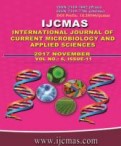


 National Academy of Agricultural Sciences (NAAS)
National Academy of Agricultural Sciences (NAAS)

|
PRINT ISSN : 2319-7692
Online ISSN : 2319-7706 Issues : 12 per year Publisher : Excellent Publishers Email : editorijcmas@gmail.com / submit@ijcmas.com Editor-in-chief: Dr.M.Prakash Index Copernicus ICV 2018: 95.39 NAAS RATING 2020: 5.38 |
The present study was conducted with 48 oats genotypes and were grown during Kharif, 2013 to assess the performance, variability, heritability, genetic advance and correlation coefficient analysis using fourteen different yield and yield contributing characters viz., days to 50% flowering, plant height (cm), total number of tillers per plant, number of productive tillers per plant, panicle length (cm), number of groats per panicle, groat weight per panicle (g), kernel weight per panicle (g), thousand groat weight (g), thousand kernel weight (g), fodder yield per plant (g), harvest index, single plant goat yield (g) and single plant kernel yield (g). Analysis of variance revealed significant differences exists among the genotypes for all the characters studied. The estimates of genotypic coefficient of variation (GCV) and phenotypic coefficient of variation (PCV) were high for, groat weight per panicle (g), kernel weight per panicle (g), harvest index, single plant goat yield (g) and single plant kernel yield (g). High heritability coupled with high genetic advance were recorded for almost all the characters. Single plant kernel yield showed significant positive correlation with total number of tillers per plant, number of productive tillers per plant, number of groats per panicle, groat weight per panicle and kernel weight per panicle thousand groat weight, thousand kernel weight, fodder yield per plant, harvest index and single plant goat yield. It was concluded that number of productive tillers per plant, number of groats per panicle and thousand groat weight are major yield contributing factors in selecting high yielding oats genotypes. This study showed that there exists a large genetic variation among oats genotypes for most of the traits which could be exploited for direct selection of high yielding genotypes. Finally expect that these novel germplasm of oats which is suitable to winter growing should be useful for plain condition.
 |
 |
 |
 |
 |